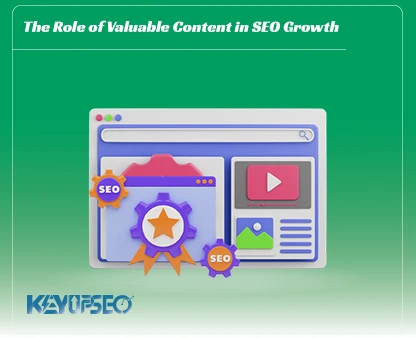
Detection of poor quality content by Google
Probably one of the questions you have asked yourself when optimizing your site is how does Google recognize poor-quality content?
To check this issue, a list of different criteria can be considered. Details such as user behavior, page loading speed, or spelling mistakes are among these things, but what should be kept in mind is that Google usually does not officially talk about its metrics and updates, and many of Google's algorithms remain a secret.
In this context, we teach how to recognize the quality of content by Google and identify the pages of the site that have poor-quality content.
According to Google statistics, every day millions of new articles are published on websites and blogs, a significant part of which are produced to rank first, and Google, although it is a programmed machine, can in most cases be very good at the quality of published content. To recognize the
If your content is known to be of high quality, you will grow in Google results with the key phrases of that page, and as a result, it will increase keyword traffic for the site and strengthen the website's SEO.
Now we want to find out how Google measures the quality of content using its crawling robots.
What does quality mean to Google?
Well, of course, Google has criteria for distinguishing quality content from poor quality content, some of which are very obvious to us, and some of which are particularly interesting. In general, the following 4 items can be effective in determining the quality of content.
- Google needs unique content and wants to make sure that the content that reaches users is of high value. As a result, it is not possible to produce non-repetitive, valuable, and useful content by just changing the words.
- Google is very interested in natural links that point to different pages. If these links are from reliable and numerous sites, from Google's point of view, it means that the page in question is of high quality and is considered a suitable and non-repeating reference that many people have cited.
- Google also cares about the quality of the links received by a page. Whether these links are external or internal, if they are received from high-quality and high-ranking pages, it is considered as a measure of quality content.
- Google also cares about user feedback in the comments section, and in this way measures the level of interest or attention of users to the content of the page. One of Google's main criteria for measuring quality content is that the content of the page answers users' questions.
How Google uses the psychology of user behavior
Interestingly, Google finds out from the behavior of users how satisfied they are with the content of the website. By searching for different terms in Google, users come across pages of different links and usually, they click on one of the links on the top of the first page of search results.
In the meantime, some users stay on that page for a long time and others leave that page and return to the Google search page. Then, without clicking on the links from the previous results, they search for a completely different phrase and go to a website with a different topic. In both cases, from Google's point of view, this behavior means that the first page has fully answered the searcher's question and solved his problem.
On the other hand, imagine that a user enters a page by clicking on one of the search results and immediately leaves the said page and clicks on another link in the results. This behavior tells Google that the first page could not answer the user's question well. If this event is repeated for a page many times, Google will reconsider the display of that page move this page to lower ranks, and display another link instead of it in the search results.
Important parameters for determining content quality
To detect the quality of content by Google robots, many parameters are examined. In the continuation of this content from the KeyUpSeo blog, we want to check the important parameters for determining the quality of the content.
Page loading speed
The low loading speed of pages also affects the assessment of poor-quality content. Because Internet users are not very patient, Google has considered the full loading speed of pages with all photos and graphics as one of the important criteria in determining the quality of content.
In addition to quick access, the responsiveness of website pages has also been suggested as one of the ways to recognize quality content.
Spelling mistakes in the text
According to the tests, it can be said with a high probability that Google's algorithms, at least in the part of widely used languages such as English, understand spelling and grammar mistakes well and remove pages with errors from their results or send them to lower ranks.
To better understand this issue, it is enough to deliberately add spelling and grammar mistakes to one of your high-quality and highly visited pages. After some time, you will see that the said page no longer has the previous rank and views. Of course, we do not recommend such trial and error!
Use the Alt tag for images
Images are one of the ways to increase the attractiveness, readability, and brevity of textual content, which is highly appreciated by internet users and search engines. However, it is not enough for Google to use only images, this search engine also emphasizes the use of Alt tags for images.
The Alt tag is a description of the subject that is inferred from the image and is displayed instead of the text when it is not loaded. Also, browsers that can read text for blind people can convey the meaning of images to this group of Internet users by reading this tag.
However, keep in mind that the Alt tag should be no more than 125 characters long, and use keywords whenever possible to have a better chance of ranking higher in Google image results. According to some experts, not using this tag means low-quality content because the images do not have enough descriptions for Google's crawlers.
Links to external sources
Thematic link of the pages is a method used by webmasters to increase the visits of users to the website and increase their duration. However, Google likes to link the content of pages to external sources to increase users' information. If these external links are to the most visited pages and are related to the topic of the page, they will affect the quality of the content.
Methods for detecting poor quality content
If we look at the story reasonably, because many of Google's algorithms are hidden, it is not possible to access all the details that this search engine considers detecting low-quality content.
However, there are criteria that, although not officially announced by Google officials, due to the various trials and errors that have been made on them, can likely be relied on to identify low-quality content and remove it from your website. Did
In general, when you search for content quality or poor quality content detection, you will come across pages that deal with topics such as Time on Site, Bounce Rate, and Organic Visitors. Although these items are of great importance for increasing the quality of content from Google's point of view, they can also be a bit misleading. However, they cannot be trusted blindly.
Now we will explain the effect of these 3 parameters.

Time on Site most pages
The long-term persistence of users on the pages can be due to their attachment and habit to your website. Meanwhile, new users may not establish such a link with you. Also, sometimes users spend some time on your website due to reading part of the content and increasing the Time on Site. However, after a while, they return to the results page and click on another link because they can't find what they are looking for.
Also, users may encounter annoying pop-up pages that take a long time to close. Although this case increases the Time on Site a little, it does not mean quality content and brings dissatisfaction to the audience. In addition, many visitors do not visit other pages and leave the website for fear of opening new pop-ups.
Reduce Bounce Rate
Bounce rate means the percentage of users who leave your site without viewing other pages after entering it. However, bounce rate cannot be a suitable measure to detect low-quality content, and it is not even directly used by Google. Google only considers the return of users from pages to mean poor quality content when they immediately click on another link in the results.
Also, people who are directed to your website through backlinks do not have a specific goal or expectation from your content. They come across a link to your page while reading an article, and if you are lucky, they click on it, and a significant percentage of them return to the reference page after reading the article. However, this does not mean that the content of your page is of poor quality. In addition, users who are informed about your new content through the newsletter are also less likely to visit other pages of the site because they read the updated content.
Organic Visitors
Organic Visitors can also sometimes mislead us. You've probably seen pages with poor-quality content that get decent traffic. These pages may rank well for terms and words that are not in your website's niche. The presence of such content on your website increases the bounce rate, and considering that the SEO keyword does not match the topic of your website, there is a strong possibility that users will click on other links in the search results after returning from the page. As a result, it is recommended to quickly remove these pages from your website or modify their content instead of being happy about getting a good ranking.
How to determine the quality of content?
Well, you may have asked if the above is so reliable for determining the quality of content, then what should be done? You can check the score qualities with your composition and quality:
- Total number of visits
- Participation rate inside and outside the site
- Number of visits to each page after viewing the landing page: If someone enters your site and from that page to other pages of the site, it is a good sign. If the user visits a few pages after logging in, it is not a good sign. However, this token should be integrated with features such as bounce rate and time on site.
- In addition to the above, you can pay attention to the visitors to measure the quality of the content. For example, some offsite indicators can be considered, including the number of external links, the rank of received links, and social networks.
- Publish content on social networks: The site republishing content on social networks such as Twitter, Facebook, and LinkedIn is also one of the signs of popularity or production as a result of its high quality. According to statistics, websites with a better ranking in Google search results (especially the first 5 ranks), more activities in social networks, especially Facebook, Twitter (X), and LinkedIn, and content that is republished more than others.
- Quality of backlinks: The number of backlinks is one of the features that shows the quality well. These links will be very beneficial if they are built naturally. The quality and rank of the websites they receive from the link are more valuable than the number of links. Google also does this very well and understands that it receives links from high-ranking websites.
- The number of domains that have linked to you
- Also, you can check the search engines.
- Content indexing: You can see the index by entering the URL of the page directly in the search engine.
- Search page rank based on its title
- Checking the click rate of pages using Google Webmaster Tools
- Duplicate check: If you search for a page address in the engine and see two similar results from your site, or if you find two links from your site by searching for the title of one of your pages in the search results, you should know that it must be in the same direction. Search your website for duplicate problem-solving.
What to do with poor-quality content?
If you have enough time and patience to review the content of your website, before doing this, it is better to consider three different categories for your content and put the content of each page in one of these baskets.
-
Important contents
Usually, considerable time is spent on producing important content. As a result, these contents have high quality and many views and comments. However, these contents do not need to be modified or deleted.
-
Average content
The second category is content that, although it needs to be modified, it is better to remain on the website. These contents do not harm your brand and do not match Google's criteria for measuring low-quality content. Their only drawback is perhaps the inconsistency with your level of expectation, which is caused by the passage of time. As a result, you can improve their quality with a better rewrite and republish.
-
Poor quality content
This category of content is not only not compatible with your taste, but it doesn't even meet Google's standards. Usually, copied content, content with many spelling and grammar mistakes, content without proper views and feedback from users, and content without reposting on social networks are included in this category.
These poor-quality contents are prone to hit your website ranking. At this time, it is better to do a small test before suddenly removing all of them. Editing these contents and turning them into high-quality content is one of the effective ways to return page rank.
You can also select a significant group of these contents and delete them after copying. Then, review the rank, amount of traffic, and indexing of the website content. If you see a significant improvement in these indicators, go through and remove other content from your website. Keep in mind that if you don't see any improvement in these indicators, either you made a mistake in the category of low-quality content or your website has other technical problems that are considered by Google for ranking.

The importance of producing quality content for website SEO
Creating quality content is always important for websites, and they usually spend a lot of money and time on it, but the question is how Google can recognize poor-quality content.
The problems of producing quality content and the problems caused by its copying have caused some people to turn to producing visual content. However, its high cost and Google's problems in recognizing the meaning of this category of content have caused written content to still cover a major part of online content.
In the meantime, you can prevent the publication of low-quality content by using simple solutions. Google has also made significant improvements compared to previous years, and it can no longer be fooled by simple rewriting and frequent use of keywords.
It seems that the best possible way to get a better rank in Google results is to be honest and produce authored content because in recent years, Google has given great importance to the behavior of users, and users also welcome new and unique content that provides them with interesting information.
These contents are quickly republished on social networks and the audience comments on them. Also, websites that publish first-rate content are recognized as references and receive many free backlinks.
In addition, websites that use high-quality content have high time on site and very little bounce rate.
Release date : 17 June, 2024













